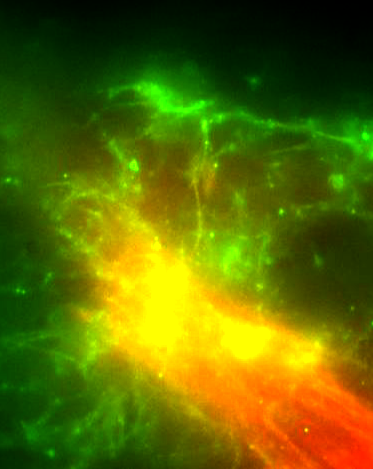Green lights in DNA-driven train track trial
 Scientists have developed a remarkable new system for chemical transport within the body, using nano-scale motors controlled by DNA.
Scientists have developed a remarkable new system for chemical transport within the body, using nano-scale motors controlled by DNA.
A team from the Oxford University and Warwick University have come together to create a transport network combining the best of the biological and technological worlds.
The system can construct its own network of tracks spanning tens of micrometres in length, transport cargo across the network and even dismantle the tracks.
The system developed by the combined University teams is built from DNA and a motor protein called kinesin. Powered by ATP fuel, kinesins move along micro-tracks controlled by attached modules made from short strands of DNA.
‘Assembler’ nanobots are made with two kinesin proteins, allowing them to arrange the tracks and assemble the network, whereas the ‘shuttles’ only need one kinesin protein for travel.
Researchers were inspired by melanophore, used by fish cells to control their colour. Tracks in the network all come from a central point, like the spokes of a wagon wheel. Pigment is moved by motor proteins either toward the centre or spread throughout the network.
“DNA is an excellent building block for constructing synthetic molecular systems, as we can program it to do whatever we need,” said Adam Wollman, a researcher at Oxford University's Department of Physics.
“We design the chemical structures of the DNA strands to control how they interact with each other. The shuttles can be used to either carry cargo or deliver signals to tell other shuttles what to do.”
“We first use assemblers to arrange the track into 'spokes', triggered by the introduction of ATP. We then send in shuttles with fluorescent green cargo which spread out across the track, covering it evenly. When we add more ATP, the shuttles all cluster in the centre of the track where the spokes meet. Next, we send signal shuttles along the tracks to tell the cargo-carrying shuttles to release the fluorescent cargo into the environment, where it disperses. We can also send shuttles programmed with 'dismantle' signals to the central hub, telling the tracks to break up,” he said.
A demonstration using fluorescent green dye as cargo has been published in Nature Nanotechnology.
The same methods could be applied to other compounds. As well as colour changes, spoke-like track systems could be used to speed up chemical reactions by bringing the necessary compounds together at the central hub.
More broadly, DNA control systems will most likely be used to enable the development of more advanced self-assembling systems.
The development was supported by the Engineering and Physical Sciences Research Council and the Biotechnology and Biological Sciences Research Council.








 Print
Print